Optical Phonecard Control Numbers
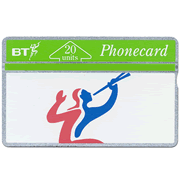
Some people collect them, others are less fussed and new people to telephone card collecting may not even know what a Phonecard control number is? Read on to discover more about Landis & Gyr optical Phonecard control numbers; what they are, how to find them and some of the many different variations.
Already know what a control number is? Use the bookmark links below to go straight to other sections of this page:
‣How to find an optical card control number?
‣How to understand and read a control number
Already know how to find and read/understand a control number?
These links to other pages may be more useful to you:
‣Phonecards without a control number
‣Phonecards with a '999' prefix control number
‣Phonecards with a 'split' control number
‣Phonecards with a 'shifted' control number
What is a telephone card? Read more about telephone cards.
What is a Control Number?
The majority of telephone cards issued around the world carry a unique number which is printed onto the Phonecard (normally) at the time of manufacturing, and acts as a serial number. Should the need arise, the telephone card could be traced back to the date, batch and factory in which it was produced.
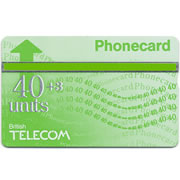 Publically issued Landis & Gyr optical telephone cards which were utlised by British Telecom (BT) in the United Kingdom between 1981 and 1996 featured control numbers on the reverse of BT Phonecards. The UK prison service continued to use Landis & Gyr optical telephone cards until 2004.
Publically issued Landis & Gyr optical telephone cards which were utlised by British Telecom (BT) in the United Kingdom between 1981 and 1996 featured control numbers on the reverse of BT Phonecards. The UK prison service continued to use Landis & Gyr optical telephone cards until 2004.
Landis & Gyr (L&G) also produced optical Phonecards for a number of other countries including: Belgium, Canada, Israel, The Netherlands, Russia, Switzerland, Taiwan and Thailand.
L&G optical telephone cards issued globally, just like those issued in the UK feature a control number on the reverse of their telephone cards too.
How to find an optical card Control Number
The vast majority of Landis & Gyr optical phonecards, including those issued by British Telecom (BT) between 1981 and 1995, feature a matt and or glossy black reverse - similar to the Phonecard pictured below on the left. The telephone cards control number can be found on this black (reverse) side in the cards corner, as circled in red.
Public issued BT Phonecards from 1995 featured full face printing on the front of the Phonecard and a grey/silver reverse - as pictured below on the right. These cards like all optical Phonecards feature a control number, and can be found in the same way as described below.
To locate a BT Phonecards control number, hold the telephone card so you are looking at the back of it. Holding the card and turning it into the light (to catch the light on the reverse of the card) you should see the control number in the bottom right hand corner.

Pictured above - The reverse of two optical BT Phonecards - the cards individual or unique control number can be found within the red circle.
If the control number appears the wrong way up for you to read, then this is considered a normal or upright control number. If however the control number is the right way up, the control number is what is known as inverted. Inverted controls are far more uncommon, compared to upright control numbers, though this does depend on the card that it appears.
The control number comprises of between 2, but more likely 9 digits/characters in total.
Congratulations - you've successfully found the control number.
Can't see the control number? No number on the reverse of the card you have? Firstly, check all four corners (and entire surface) of the reverse of the Phonecard. Still no control? Please see 'Phonecards without a control number' web page.
How to understand and read a Control Number
Now you've found the optical Phonecards control number, the next thing is understanding what the numbers actually mean.
Optical BT Phonecard control numbers fall (in the main*) within three different formats or methods used between the following years:
1. BT Phonecards produced between 1981 to 1983
2. BT Phonecards produced between 1984 to 1994, and high volume public issues until 1996
3. Smaller quantities of cards produced between 1994 to 1997
*Some of the very first BT telephone cards are known to exist with a control number comprising of either 2, 3, 4, 5 or 6 digits.
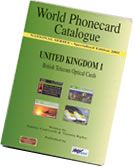 It is important to first know from which era the phonecard you have is from. If you are unsure, read on to learn more about the different control number formats that were used.
It is important to first know from which era the phonecard you have is from. If you are unsure, read on to learn more about the different control number formats that were used.
The following section has been created using information found within the World Phonecard Catalogue United Kingdom 1 (pictured right). The catalogue features all optical BT Phonecards issues between 1981 and 1997, and also includes the first three digits/characters of each cards control number or numbers. Buy a copy of the UK 1 World Phonecard catalogue.
1. BT Phonecards produced between 1981 to 1983
Early BT Phonecards were produced in Switzerland by the manufacturer Landis & Gyr / Sodeco. The control numbers found on the reverse of these cards feature the letter G at the start of control number e.g. G156249. The letter 'G' indicates Great Britain.
The control numbers of definitive 'green' cards produced between 1981 and 1983 in Switzerland had the following prefix G0, G1, G2, G4, G5 or G6, followed by a 6 digit number, like the example below.
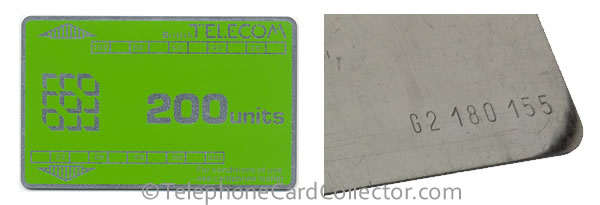
Pictured above - Face of definitive 1st issue 200unit BT Phonecard (left) and cards control number on the reverse (right).
In 1984 production of Landis & Gyr BT Phonecards moved to Landis & Gyr's UK factory in Acton, London, and the format for BT Phonecards control numbers changed.
2. BT Phonecards produced between 1984 to 1994, and high volume public issues until 1996
The majority of BT optical telephone cards follow this second method or layout of the control number found on the reverse of the card.
In addition, public issued cards e.g. definitive 'green' cards and other high volume cards continued to use this control number format until optical BT cards were replaced with chip cards in 1996.
To help understand the control number found on optical BT Phonecards between 1984 and 1994/1996, I've used a BT English Heritage 50 unit Phonecard.
The card has the following control number: 528G09969 which is pictured below.
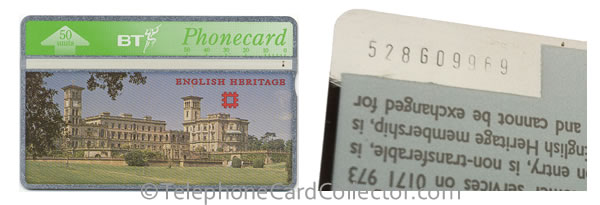
Pictured above - Face of English Heritage BT Phonecard (left) and cards control number on the reverse (right).
Control number explanation
‣The first number 5 = the year of manufacturer, which in the case of the this card is 1995.
‣The second and third numbers 28 = the month the card was manufactured, which is August.
‣Next appears is a letter G = the batch number that the card is part of.
‣The subsequent and following numbers are the unique cards number within the batch and start at 00000 and end at 99999. This particular card is the 9,969th card in the 'G' batch or run.
Notes and further explanation to the control number:
Batch numbers between A to Z were used, excluding I, J and O.
Did you know? Some cards were produced in their millions, to accommodate this a sub batch/control number was used:- A, B, C, D, E, F, G, H, K e.g. 101A, 101B and so on...
Some collectors collect cards based on the batch number for each telephone card. On the face of it (on the front of the card) they would look identical, but the control number tells a very different story.
3. Smaller quantities of cards produced between 1994 to 1997
BT Phonecards produced in smaller quantities from 1994 saw a different format developed for the cards control number.
These cards, unlike previous BT Phonecards already had the control number printed onto the reverse of the card and were also already pre-encoded with a number of units e.g. 10units before the design of the card was printed.
To help understand the new control number layout for smaller quantities of cards produced between 1994 and 1997, I've picked a mint full face printed BT Phonecard featuring Alliance & Leicester / Giro Banking.
The card has the following control number: 620A26443 which is pictured below.
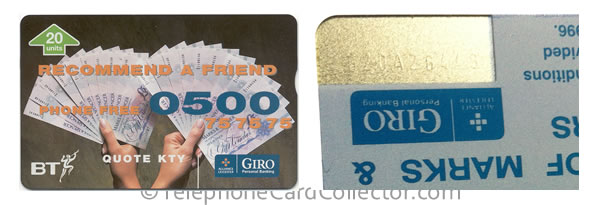
Pictured above - Face of Alliance & Leicester BT Phonecard (left) and cards control number on the reverse (right).
Control number explanation
‣The first number 6 = the year of manufacturer, which in the case of the this card is 1995.
‣The second and third numbers 20 = the numbers of unit the Phonecard has, which is 5units.
‣Next appears is a letter A = the month the card was manufactured, which is April.
‣The subsequent and following numbers are the unique cards number within the batch and start at 00000 and end at 99999. This particular card is the 26,443th card in the cards sequence.
Notes and further explanation to the control number:
The second and third digits which signifies the number of units the card has, use the following: 05 = 5units, 10 = 10units, 20 = 20units, 50 = 50units, 00 = 100units.
The forth digit, a letter and which signifies the month he card was manufactured uses the following: A = January, B = February, C = March, D = April, E = May, F = June, G = July, H = August, J = September, K = October, L = November, M = December - A to M, excluding I.
Do you have a optical BT Phonecard without a control number? I'd be keen to hear from you, please contact me and tell me more about the card, or better still, send over a photo or scan of both sides of the telephone card.
Plus if you are a collector and would like to contribute content, images or information to this page, please also contact me.
Last updated: 2nd January 2026
Popular Pages
Collector Shop
Site Maps
TelephoneCardCollector.com © 2013-2026
Please do NOT copy any content without prior consent, thank you.

